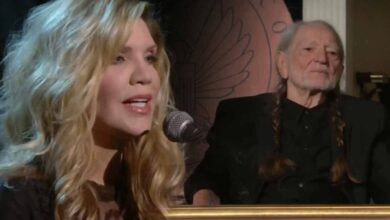“Four Walls,” a Jim Reeves Classic, Covered by Various Talents
“Four Walls,” composed in 1951 by lyricist Marvin J. Moore and musician George H. Campbell Jr., languished for six years before finding its voice. The song, steeped in melancholy, narrates the tale of unrequited love, with the titular “four walls” bearing witness to the narrator’s longing for a love that never returns.
The piece seemed to be biding its time, much like its theme of waiting, until it caught the attention of Jim Reeves in Chet Atkins’ office. Despite Atkins’ initial hesitation, believing the song better suited to a female voice, Reeves’ conviction led to its recording on February 7, 1957. Distinct from his usual vigorous vocal style, Reeves sought a softer, more intimate rendition, positioning himself closer to the microphone to achieve this effect.
The recording was supported by an ensemble of skilled musicians: Bob Moore on bass, Chet Atkins on guitar, Farris Coursey on drums, Floyd Cramer on piano, and The Jordanaires providing vocal harmonies. This collective effort propelled “Four Walls” to the summit of the country charts and to a commendable position on the pop charts in 1957.
The song’s swift ascent to success post-release inspired a plethora of artists to cover it, making it a frequently revisited piece from 1957 through 1995. Early covers include those by Jim Lowe and Michael Holiday in 1957, with Lowe’s rendition achieving significant acclaim on the Billboard charts.
The song’s adaptability was further demonstrated in the 1960s, with covers by Kay Starr and Patti Page, and it continued to resonate with artists in the ensuing decades. Bing Crosby, Connie Francis, B.J. Thomas, and Jerry Lee Lewis were among those who lent their voices to this enduring ballad, each bringing their unique style to the song.
The 1970s saw Vera Lynn’s inclusion of “Four Walls” in her album, and the 1980s celebrated the song with Ronnie Milsap’s tribute to Jim Reeves. Willie Nelson’s cover in 1995 marked another high point, underscoring the song’s lasting legacy and its profound impact across generations of country music artists.





